Category: Еру Dnieper Hydroelectric Station (The DniproHES) archaeological expedition
DNIEPER HYDROELECTRIC STATION ARCHAEOLOGICAL EXPEDITION (1927–1933)
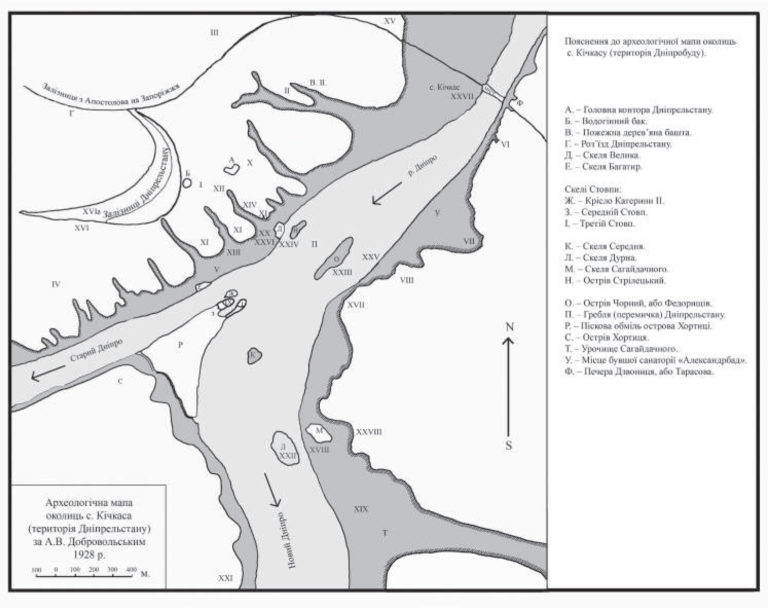 In the archaeological literature, studies of 1927–1932 on the construction of the fifth stage of the lower part of the cascade of hydroelectric stations on the Dnieper River in Zaporizhzhia city are known as Dniprohes, Dniprobudivska, Dniprelstan, DniproHES, Dniprostroivska (Russian). The organization and scientific management of a comprehensive study of the area to be flooded was entrusted to the Commission for the study of the Dniprelstan territory at the Joint Meeting of the All-Ukrainian Academy of Sciences (the AUAS), established in February 1927 on the initiative of the Presidium of the Ukrainian Main Department of Scientific Institutions at the People’s Commissariat of Education of the USSR (Ukrnauka). The functions of the Commission in the organizational part included coordination of expeditions and detachments, approval of research plans, preparation of annual reports by direction and general estimate, its coordination with the Ukrnauka, the State plan, the People’s Commissariat of Finance.
In the archaeological literature, studies of 1927–1932 on the construction of the fifth stage of the lower part of the cascade of hydroelectric stations on the Dnieper River in Zaporizhzhia city are known as Dniprohes, Dniprobudivska, Dniprelstan, DniproHES, Dniprostroivska (Russian). The organization and scientific management of a comprehensive study of the area to be flooded was entrusted to the Commission for the study of the Dniprelstan territory at the Joint Meeting of the All-Ukrainian Academy of Sciences (the AUAS), established in February 1927 on the initiative of the Presidium of the Ukrainian Main Department of Scientific Institutions at the People’s Commissariat of Education of the USSR (Ukrnauka). The functions of the Commission in the organizational part included coordination of expeditions and detachments, approval of research plans, preparation of annual reports by direction and general estimate, its coordination with the Ukrnauka, the State plan, the People’s Commissariat of Finance.
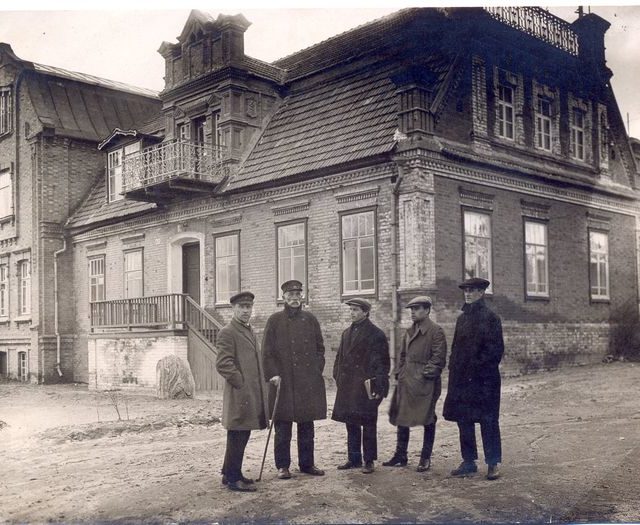 The commission developed and agreed on a comprehensive plan for the research of the territory “in the fields of geology, geography, water management, ichthyology, botany, fauna… anthropology, archaeology, historical geography, art history, ethnology, folklore, music ethnography, customary law, dialects and terminology”, and also the calculation of works for the current year in the amount of 120,000 karbovanetsiv was made. It was also decided to cover the experiments in the joint collection «[Studies on the research of the territory] of Dniprelstan». Academician L.M. Yasnopolskyi was a chairman of the Commission for the entire period of its existence (1927–1933).
The commission developed and agreed on a comprehensive plan for the research of the territory “in the fields of geology, geography, water management, ichthyology, botany, fauna… anthropology, archaeology, historical geography, art history, ethnology, folklore, music ethnography, customary law, dialects and terminology”, and also the calculation of works for the current year in the amount of 120,000 karbovanetsiv was made. It was also decided to cover the experiments in the joint collection «[Studies on the research of the territory] of Dniprelstan». Academician L.M. Yasnopolskyi was a chairman of the Commission for the entire period of its existence (1927–1933).
The Commission consisted of «various academic institutions and representatives outside academic institutions» including representatives of all mentioned scientific areas. Archaeological direction in the Commission was represented by the heads of the All-Ukrainian Archaeological Committee (the AUAC) successively – academician O.P. Novytskyi, D.M. Shcherbakivskyi (until July 1927), D.I. Yavornytskyi, then the Director of the Dnipropetrovsk Regional Historical and Archaeological Museum, corresponding member (since June 29, 1929 – a full member of the All-Ukrainian Academy of Sciences).
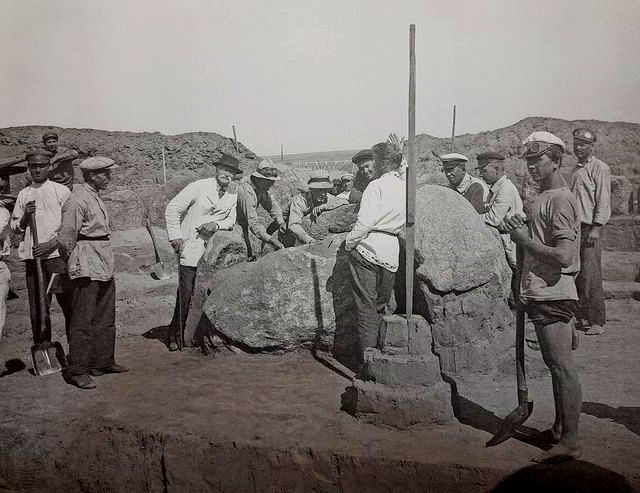
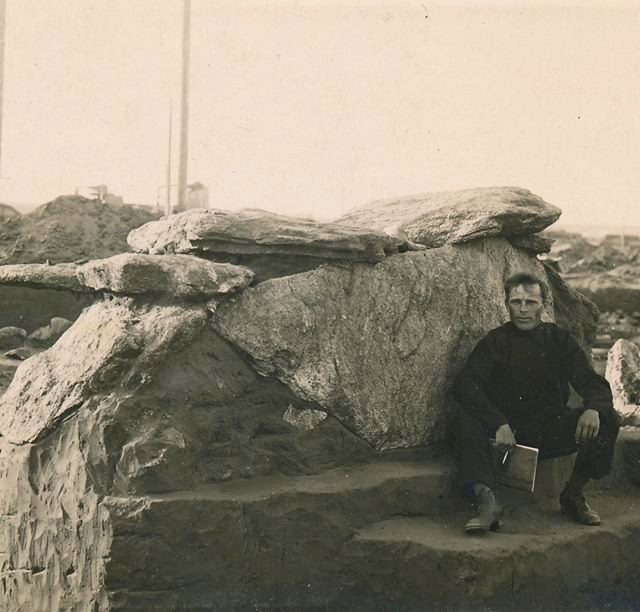 Historians, archaeologists, museum workers, and local historians who had good professional training worked in the archaeological expedition in different years: A.V. Dobrovolskyi (the Kherson Museum), P.I. Smolichev (the Chernihiv Local History Museum), F (T). M. Kiranov (the Nikopol Local History Museum), I.O. Chasovnykov (the Artemivsk Museum), S.S. Hamchenko (the AUAC, Kyiv), P.A. Kozar (District Inspector for the Protection of Cultural Monuments, Dnipropetrovsk), V. A. Hrinchenko (The Central Proletarian Museum of Poltava Region), M. Ya. Rudynskyi (The Central Proletarian Museum of Poltava Region), F.N. Sapian (The Dnipropetrovsk Regional Historical and Archaeological Museum), A.K. Takhtai (the Central Proletarian Museum of Poltava Region), M.O. Miller (the Dnipropetrovsk Regional Historical and Archaeological Museum), T.T. Teslia (the Dnipropetrovsk Regional Historical and Archaeological Museum), I.F. Levytskyi (Volhynia), N.H. Avramenko (the Kharkiv Historical Museum), and etc.
Historians, archaeologists, museum workers, and local historians who had good professional training worked in the archaeological expedition in different years: A.V. Dobrovolskyi (the Kherson Museum), P.I. Smolichev (the Chernihiv Local History Museum), F (T). M. Kiranov (the Nikopol Local History Museum), I.O. Chasovnykov (the Artemivsk Museum), S.S. Hamchenko (the AUAC, Kyiv), P.A. Kozar (District Inspector for the Protection of Cultural Monuments, Dnipropetrovsk), V. A. Hrinchenko (The Central Proletarian Museum of Poltava Region), M. Ya. Rudynskyi (The Central Proletarian Museum of Poltava Region), F.N. Sapian (The Dnipropetrovsk Regional Historical and Archaeological Museum), A.K. Takhtai (the Central Proletarian Museum of Poltava Region), M.O. Miller (the Dnipropetrovsk Regional Historical and Archaeological Museum), T.T. Teslia (the Dnipropetrovsk Regional Historical and Archaeological Museum), I.F. Levytskyi (Volhynia), N.H. Avramenko (the Kharkiv Historical Museum), and etc.
Photofixation was carried out by E.O. Fedorovych, M.N. Zalizniak (1932), drawing works, in addition to detachment leaders, were carried out by I.D. Yevseievskyi, M.L. Makarevych, V.S. Samus, V.S. Solianyk, I. Yu. Chernysh. The technical workers in the expedition were excavators assigned by the Directorate of Dnieper Construction and recruited in the villages on the recommendation of village councils and labor inspections under the so-called “Hiring on the labor front.”
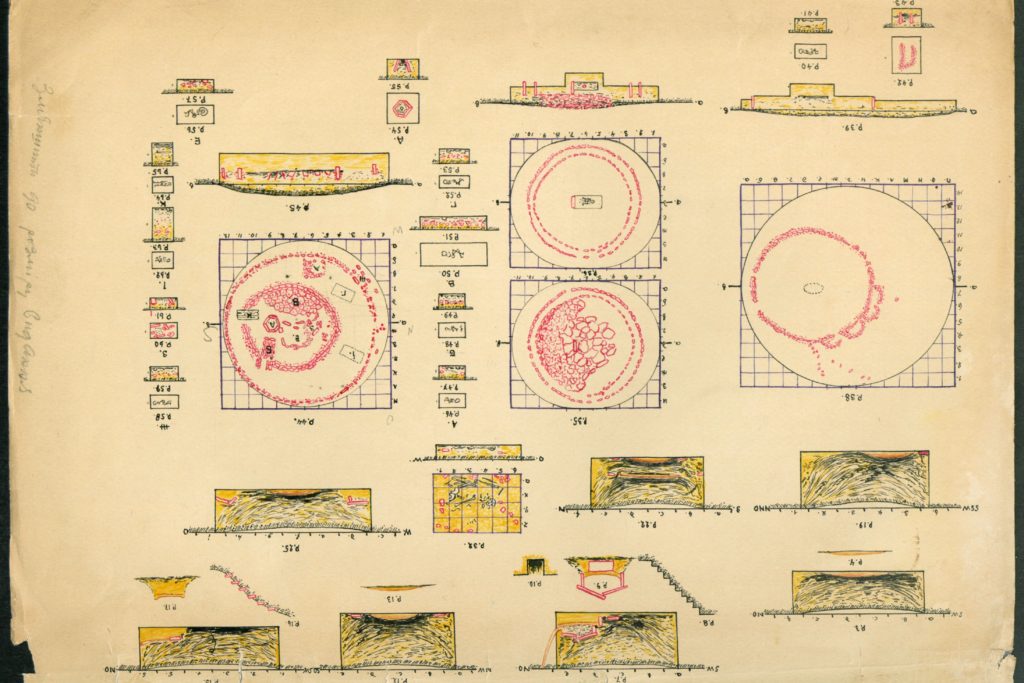 In terms of scientific significance, large-scale works and achievements of the expedition for many decades determined the development of archaeological science. In terms of the amount of work at that time, the Dnieper Hydroelectric Station Archaeological expedition in the USSR had no equal. The first results of the research were published in the «Collection of the Dnipropetrovsk Regional Historical and Archaeological Museum» (Dnipropetrovsk, 1929). According to the results of excavations in 1928, there were made publications by S.S. Hamchenko, V.A. Hrinchenko, P.A. Kozar, P.I. Smolichev, F.N. Kiranov, and I. S. Pasko. Several annual scientific reports were published by D.I. Yavornytskyi in the academic collections of the 1930-ies.
In terms of scientific significance, large-scale works and achievements of the expedition for many decades determined the development of archaeological science. In terms of the amount of work at that time, the Dnieper Hydroelectric Station Archaeological expedition in the USSR had no equal. The first results of the research were published in the «Collection of the Dnipropetrovsk Regional Historical and Archaeological Museum» (Dnipropetrovsk, 1929). According to the results of excavations in 1928, there were made publications by S.S. Hamchenko, V.A. Hrinchenko, P.A. Kozar, P.I. Smolichev, F.N. Kiranov, and I. S. Pasko. Several annual scientific reports were published by D.I. Yavornytskyi in the academic collections of the 1930-ies.
 As for the fate of the collections, even before the completion of the expedition by the order of the Ukrnauka, they were distributed among the museums of Dnipropetrovsk, Zaporizhzhia (The Dnieper Construction Museum), Kharkiv, Odessa. A significant volume of collections in 1934 (about 100 thousand units) was transported from Dnipropetrovsk to Kyiv and transferred to the Institute of History of Material Culture (now the Institute of Archaeology of the NAS of Ukraine). During the occupation in 1942, the archaeological collections were transferred to the National Museum of Pre- and Early History, headed by the German archaeologist Paul Grimm and the Ukrainian archaeologist P.P. Kurinnyi. In 1943, the archaeological collections, along with others, were taken to Germany, and after returning to Kyiv (1948), they were transferred to the Kyiv Historical Museum (now the National Museum of History of Ukraine). Field documentation (reports, diaries, drawings, photos, etc.) are stored in the Scientific Archive of the Institute of Archaeology of the National Academy of Sciences of Ukraine.
As for the fate of the collections, even before the completion of the expedition by the order of the Ukrnauka, they were distributed among the museums of Dnipropetrovsk, Zaporizhzhia (The Dnieper Construction Museum), Kharkiv, Odessa. A significant volume of collections in 1934 (about 100 thousand units) was transported from Dnipropetrovsk to Kyiv and transferred to the Institute of History of Material Culture (now the Institute of Archaeology of the NAS of Ukraine). During the occupation in 1942, the archaeological collections were transferred to the National Museum of Pre- and Early History, headed by the German archaeologist Paul Grimm and the Ukrainian archaeologist P.P. Kurinnyi. In 1943, the archaeological collections, along with others, were taken to Germany, and after returning to Kyiv (1948), they were transferred to the Kyiv Historical Museum (now the National Museum of History of Ukraine). Field documentation (reports, diaries, drawings, photos, etc.) are stored in the Scientific Archive of the Institute of Archaeology of the National Academy of Sciences of Ukraine.
Serhii Hamchenko participated in archaeological work in Dniprelstan (the city of Zaporizhzhia) in 1928. At that time, he was an active member of the All-Ukrainian Archaeological Committee (UAK) and held the position of its vice-president. Hamchenko worked there in April – May 1928. He mainly explored the sights on the right and left banks of the Dnieper in the territory of the so-called Kichkas settlement. The works were carried out according to the plan drawn up by A. V. Dobrovolskyi. The junior archaeologist of the expedition V. A. Grinchenko and K. M. Sergiiv (ref. 87) worked as part of the detachment. The photo fixation was carried out by the expedition photographer E. O. Fedorovych (ref. 89).
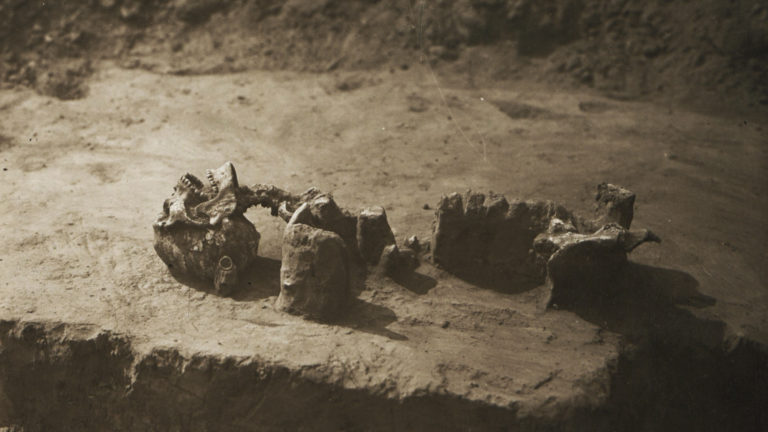 In the course of the work, a detachment under the leadership of Serhii Hamchenko investigated dugouts on the left bank of the Dnieper (Nos. 1–8), burial grounds (I, II); burial near the beams of Vilna, Krynychka (Krynychna); Gadyucha, village Fedorivka (right bank of the Dnieper) [Ref. 87]. On the right bank of the Dnieper near the village Burials, stone cromlechs (7 burials) of the Bronze Age were investigated in Kichkas. (ref. 89). The archive also contains the excavation diary of S. Hamchenko (April 14 – May 30, 1928) [ref. 86] and the scientific work “My archaeological researches of 1928 in Dniprelstan” (October 1, 1928; file 88) prepared on the basis of excavation materials. The work was submitted to the collection of the Ukrainian Academy of Sciences “Studies for the study of the territory of Dniprelstan” (the manuscript is kept in the Institute of Manuscripts of the NBUV).
In the course of the work, a detachment under the leadership of Serhii Hamchenko investigated dugouts on the left bank of the Dnieper (Nos. 1–8), burial grounds (I, II); burial near the beams of Vilna, Krynychka (Krynychna); Gadyucha, village Fedorivka (right bank of the Dnieper) [Ref. 87]. On the right bank of the Dnieper near the village Burials, stone cromlechs (7 burials) of the Bronze Age were investigated in Kichkas. (ref. 89). The archive also contains the excavation diary of S. Hamchenko (April 14 – May 30, 1928) [ref. 86] and the scientific work “My archaeological researches of 1928 in Dniprelstan” (October 1, 1928; file 88) prepared on the basis of excavation materials. The work was submitted to the collection of the Ukrainian Academy of Sciences “Studies for the study of the territory of Dniprelstan” (the manuscript is kept in the Institute of Manuscripts of the NBUV).
Svitlana Liashko
Fig. 1
The drawing was made after «Schematic archaeological map of the territory of the Dniprelstan in Kichkas village in Zaporizhzhia district, compiled by A.V. Dobrovolskyi» (1927). From the article:
Yakubenko O. Materialy z pokhovan doby piznoi bronzy na o. Durna Skelia v Nazhporizhzhi (iz zibrannia Natsionalnoho muzeiu istorii Ukrainy) // Zbirnyk materialiv arkheolohiia & fortyfikatsiia Ukrainy IX Mizhnarodnoi naukovo-praktychnoi konferentsii Kamianets-Podilskoho derzhavnoho istorychnoho muzeiu-zapovidnyka, prysviachenoi 160-i richnytsi vid dnia narodzhennia Sitsinskoho Yukhyma Yosypovycha (1859–1937) ta 100-i richnytsi vid dnia narodzhennia Tymoshchuka Borysa Onysymovycha (1919–2003). – Kamianets-Podilskyi, 2019. – S. 50–56.
Fig. 2
Participants of the Dnieper Hydroelectric Station Archaeological expedition E.O. Fedorovych, S.S. Hamchenko, V.A. Hrinchenko, V.S. Solianyk, A.V. Dobrovolskyi (1928). The photo was taken on the background of the house where the Len family lived until 1927 (the German settlement of Ainlage-Kichkas on the Right bank of the Dnieper). In 1928, archaeologists lived in this house.
Fig. 3
D.I. Yavornytskyi at the excavation of the mound near Kichkas village. Discovering of the central burial on the site where the detachment led by S.S. Hamchenko worked (1928).
Fig. 4
V.A. Hrinchenko on the background of burial in the «stone tomb» (003_01_0089_0098). From April to May 1928, the archaeologist worked in the S.S. Hamchenko’s detachment.
Fig. 5
Illustrations to S.S. Hamchenko’s article «My Archaeological Research in 1928 in Dniprelstan» prepared by the author. (October 10,1928)
Fig. 6
«They carry a packaged burial» (Kichkas village, burial No. 3)
Fig. 7
The burial of a middle-aged woman on her back “strongly bent to the left with her legs thrown to her chest”, possibly buried in a sitting position with her head to the south-west. The bones are painted ocher. Two silver earrings with a diameter of 2.2 cm and five fragments of earthenware were found near the temples. The grave at a depth of 0.6 m is surrounded by 4.5×4.1 m stones. The burial was found on the right bank of the Dnieper near the settlement Kichkas near dugout No. 1. Excavations April 20–21, 1928.
